Toyota Tacoma (2005–2015) Owners Manual: If your vehicle needs to be towed
If towing is necessary, we recommend having your vehicle towed by your Toyota dealer or a commercial towing service, using a lift-type truck or a flat bed truck.
Use a safety chain system for all towing, and abide by all state/provincial and local laws.
The wheels and axle on the ground must be in good condition.
If they are damaged, use a towing dolly or flat bed truck.
Before towing
The following may indicate a problem with your transmission. Contact your Toyota dealer before towing.
● The engine is running, but the vehicle will not move.
● The vehicle makes an abnormal sound.
Emergency towing (4WD models and PreRunner only)
If a tow truck is not available, in an emergency your vehicle may be temporarily towed using a cable or chain secured to the emergency towing hook. This should only attempted on hard, surfaced roads for short distances at low speeds.
A driver must be in the vehicle to steer and operate the brakes. The vehicle’s wheels, drive train, axles, steering and brakes must be in good condition.
 Type A
Type A
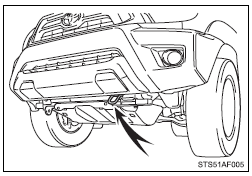
Towing hook
 Type B
Type B
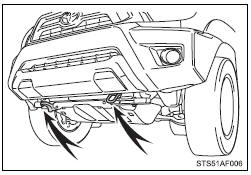
Towing hook
■Emergency towing procedure
 The engine switch must be in the
ACC (engine off) or the ON (engine running) position.
The engine switch must be in the
ACC (engine off) or the ON (engine running) position.
 4WD models: Put the front-wheel
drive control switch in H2.
4WD models: Put the front-wheel
drive control switch in H2.
 Put the shift lever in N.
Put the shift lever in N.
 Release the parking brake.
Release the parking brake.
CAUTION
■Caution while towing
●Use extreme caution when towing the vehicle.
Avoid sudden starts or erratic driving maneuvers which place excessive stress on the emergency towing hook and the cables or chains. Always be cautious of the surroundings and other vehicles while towing.
●If the engine is not running, the power assist for the brakes and steering will not function, making steering and braking more difficult.
NOTICE
■Emergency towing hook precautions
●Before emergency towing, check that the hook is not broken or damaged.
●Fasten the towing cable or chain securely to the hook.
●Do not jerk the hook. Apply steady and even force.
●To avoid damaging the hook, do not pull from the side or at a vertical angle. Always pull straight ahead.
Towing with a sling-type truck
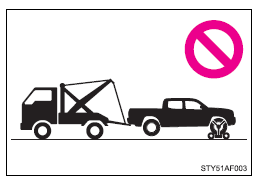
NOTICE
■To prevent body damage
Do not tow with a sling-type truck, either from the front or rear.
Towing with a wheel lift-type truck from the front
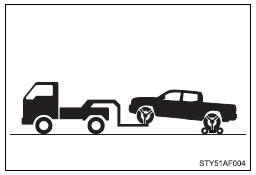
Vehicles with an automatic transmission: Use a towing dolly under the rear wheels.
2WD models with a manual transmission: We recommend to use a towing dolly under the rear wheels.
When not using a towing dolly, release the parking brake and shift the shift lever to N.
4WD models with a manual transmission: We recommend to use a towing dolly under the rear wheels.
When not using a towing dolly, release the parking brake, shift the shift lever to N and put the front-wheel drive control switch in H2.
NOTICE
■To prevent causing serious damage to the transmission (vehicles with an automatic transmission)
Never tow this vehicle wheels on the ground.
Towing with a wheel lift-type truck from the rear
 2WD models
2WD models
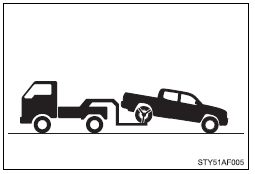
Turn the engine switch to the ACC position.
 4WD models
4WD models
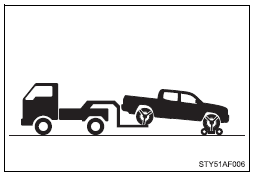
We recommend to use a towing dolly under the front wheels.
When not using a towing dolly, turn the engine switch to the ACC position, shift the shift lever to N and put the front-wheel drive control switch in H2.
NOTICE
■To prevent damaging the vehicle
●Do not tow the vehicle with the key removed or in the LOCK position.
The steering lock mechanism is not strong enough to hold the front wheel straight.
●When raising the vehicle, ensure adequate ground clearance for towing at the opposite end of the raised vehicle. Without adequate clearance, the vehicle could be damaged while being towed.
Using a flat bed truck
 Type A
Type A
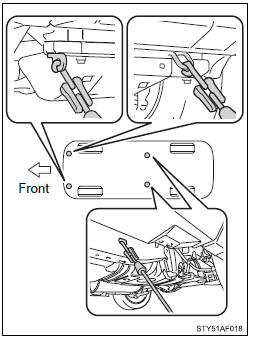
If your Toyota is transported by a flat bed truck, it should be tied down at the locations shown in the illustration.
 Type B
Type B
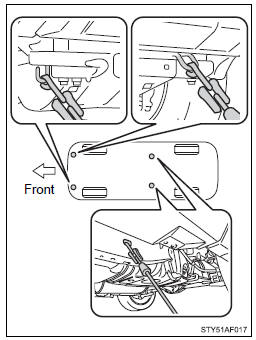
If your Toyota is transported by a flat bed truck, it should be tied down at the locations shown in the illustration.
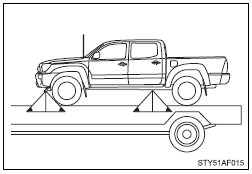
If you use chains or cables to tie down your vehicle, the angles shaded in black must be 45°.
Do not overly tighten the tie downs or the vehicle may be damaged.
Apply the parking brake firmly.
 Emergency flashers
Emergency flashers
Use the emergency flashers if the vehicle malfunctions or is involved in an
accident.
Press the switch to flash all the turn signal lights. To turn them off, press
the switch once again.
NOTIC ...
 If you think something is wrong
If you think something is wrong
If you notice any of the following symptoms, your vehicle probably needs adjustment
or repair. Contact your Toyota dealer as soon as possible.
■ Visible sympt
● Fluid leaks under the v ...
Other materials:
On-vehicle Inspection
ON-VEHICLE INSPECTION
PROCEDURE
1. INSPECT LOWER NO. 2 INSTRUMENT PANEL AIRBAG ASSEMBLY (for Vehicle not Involved
in Collision)
(a) Perform a diagnostic system check (See page
).
(b) With the lower No. 2 instrument panel airbag assembly ...
Touch Panel Switch does not Function
PROCEDURE
1.
CHECK MULTI-DISPLAY
(a) Check if there is any foreign matter caught between the display and exterior
frame of the multi-display.
OK:
No foreign matter is caught between the display and exterior frame of the multi-display.
HINT:
If there is foreig ...
Pressure Control Solenoid "B" Performance (Shift Solenoid Valve SL2) (P0776)
SYSTEM DESCRIPTION
The ECM uses the vehicle speed signal and signals from the transmission revolution
sensors (NT, SP2) to detect the actual gear (1st, 2nd, 3rd, 4th, 5th or 6th gear).
The ECM compares the actual gear with the shift schedule in the ECM memory to
detect mechanical problems of t ...
